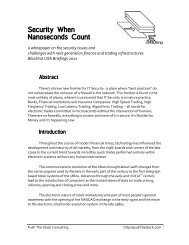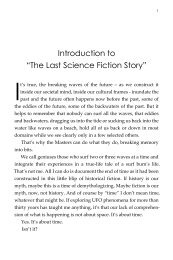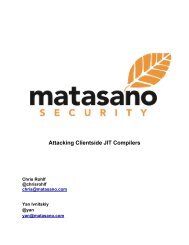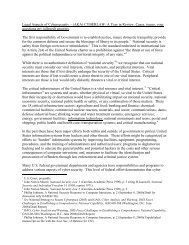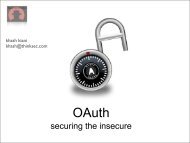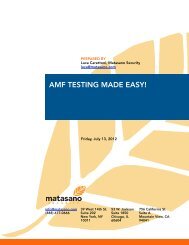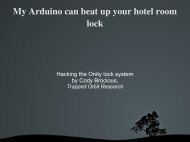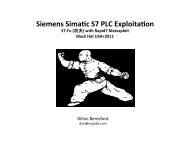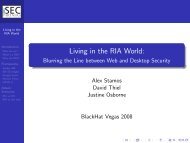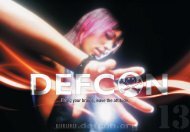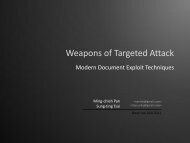You also want an ePaper? Increase the reach of your titles
YUMPU automatically turns print PDFs into web optimized ePapers that Google loves.
<strong>Bitsquatting</strong> <br />
DNS Hijacking without Exploitation <br />
Artem Dinaburg (artem.dinaburg@raytheon.com, artem@dinaburg.org) <br />
Raytheon Company <br />
July, 2011 <br />
Cleared for public release. Reference #2011-‐307 <br />
Copyright © 2011 Raytheon Company. All rights reserved.
1 Introduction <br />
Computer hardware, especially RAM, can suffer from random errors that manifest <br />
as corruption of one or more bits. The causes of these errors range from <br />
manufacturing defects to environmental factors such as cosmic rays and <br />
overheating. While the probability of a single error is small, the total error amount <br />
in all RAM connected to the Internet is significant. Malicious attackers can exploit <br />
these random errors remotely. <br />
This paper presents an attack called bitsquatting that leverages random errors and <br />
DNS to direct Internet traffic to attacker-‐controlled destinations. To prove the <br />
feasibility of bitsquatting, several frequently resolved domains were bitsquatted and <br />
all HTTP requests to the subsequent domains were logged. An analysis of six months <br />
of log data reveals that virtually every operating system and platform is affected. <br />
Fortunately, bitsquatting attacks are easy to mitigate. <br />
The rest of this paper is as follows: Section 2 discusses computer hardware errors, <br />
the causes of those errors, and measured error rates. Previous use of bit errors to <br />
defeat security mechanisms is reviewed in Section 3. The bitsquatting attack, <br />
intuition behind it, and the experiment design is described in Section 4. Six months <br />
of bitsquatting logs from the experiment are analyzed in Section 5. Effective <br />
mitigations and countermeasures against bitsquatting attacks are presented in <br />
Section 6. <br />
2 Computer Hardware Errors <br />
Software writers implicitly assume computer hardware and other electronic <br />
components operate correctly. This assumption is not always true. Computer <br />
hardware, including various information transmission and storage media, does <br />
experience errors. One possible hardware error is a bit-‐error. When a bit-‐error <br />
occurs, one or more of the internal representations of a bit stored in hardware <br />
transition from a 0 to a 1, or from a 1 to a 0. <br />
Bit-‐errors and other hardware errors occur in production hardware. Section 2.1 <br />
describes several causes of bit-‐errors, and documented cases of their occurrence. <br />
Section 2.2 summarizes previous studies measuring bit-‐error rates due to various <br />
causes. The use (or lack thereof) and effectiveness of error correcting codes is <br />
covered in Section 2.3. <br />
Cleared for public release. Reference #2011-‐307 <br />
Copyright © 2011 Raytheon Company. All rights reserved. <br />
1
2.1 Causes of Bit-‐errors <br />
Manufacturing defects, contamination, operation outside environmental tolerances, <br />
and radiation are some of the documented causes of bit-‐errors in production <br />
hardware. There are several well-‐known examples of bit-‐errors occurring in the <br />
wild. <br />
2.1.1 Manufacturing Defects and Contamination <br />
A famous design and manufacturing defect of the Sun UltraSparc II CPU is described <br />
by Peter Baston in the SPARCproductDIRectory [1]. To summarize, servers using <br />
UltraSparc II CPUs would randomly fail for no apparent reason. The problem was <br />
eventually traced back to SRAM contaminated with an alpha radiation emitter <br />
during manufacturing. The radiation would cause bit-‐errors in the processor’s <br />
cache, resulting in random data corruption and server crashes. The problem was <br />
exacerbated by the lack of error checking and correction on the processor’s SRAM. <br />
Thousands of processors had to be replaced. <br />
Anecdotal evidence of bad RAM abounds on the Internet. Some of these anecdotes <br />
are likely based in fact. Manufacturing defects in DRAM are common enough for <br />
applications like memtest86 to exist and to ship on every Ubuntu LiveCD. <br />
2.1.2 Operating Outside Environmental Tolerances <br />
Electrical resistance and conductance are affected by temperature [2]. Electronic <br />
components are rated to operate at given temperature ranges, humidity levels, and <br />
electrical characteristics. Modern desktops and servers rely on active cooling to <br />
maintain operational temperature. These cooling systems can fail, leading to <br />
operation outside environmental tolerances. Unstable and intermittent power <br />
supplies can violate electrical tolerances of electronic components. Researchers <br />
have used heat lamps to cause bit-‐errors in DRAM [3], and electrical glitching to <br />
induce bit-‐errors in portable devices and smartcards [4] [5]. <br />
Mobile devices are frequently used outdoors and are especially at risk of operating <br />
outside designed <br />
Phone Minimum (°F) Maximum (°F) Reference <br />
environmental tolerances. For Apple iPhone 4 32 95 [6] <br />
BlackBerry 8130 Pearl 32 122 [7] <br />
example, the operating <br />
BlackBerry 8700g 32 122 [8] <br />
temperature requirements for BlackBerry Bold 9700 32 104 [9] <br />
several mobile phones are <br />
HTC Imagio 32 104 [10] <br />
Nokia E62 14 104 [11] <br />
shown in Table 1. The <br />
Samsung SGH-‐600 14 130 [12] <br />
operating temperature range Siemens A65 14 130 [13] <br />
Table 1: Mobile phone operating temperatures, in Fahrenheit. The <br />
for the iPhone 4 (32° F to 95° <br />
maximums and minimums are routinely exceeded in many populated <br />
F) is not only occasionally regions of the world. <br />
exceeded outdoors in most of the world, but populated regions routinely experience <br />
climates well outside this range. <br />
Cleared for public release. Reference #2011-‐307 <br />
Copyright © 2011 Raytheon Company. All rights reserved. <br />
2
2.1.3 Radiation <br />
High-‐energy particles from cosmic rays can interact with electrical components. Far <br />
from being a remote phenomenon, some studies conclude that cosmic rays are <br />
actually the primary source of bit-‐errors in DRAM at ground level [14]. <br />
Cosmic rays are more prevalent at higher altitudes and at latitudes closer to the <br />
poles [15]. The direction of cosmic rays also varies; many more come from the <br />
vertical direction than the horizontal [16]. An IBM study determined that cosmic <br />
rays affect DRAM and found error rates at sites above 2600 feet to be five times that <br />
of ground level. Denver, CO (altitude 5280 ft.) had error rates ten times that of <br />
ground level [17]. The same study also concluded that DRAM orientation did not <br />
affect error rates, as the cross-‐section vulnerable to cosmic rays remained constant. <br />
2.2 Bit-‐error Rates <br />
The first reports of intermittent electronics failure occurred in 1954-‐1957, during <br />
aboveground nuclear testing [17]. In 1978 bit errors were first observed in <br />
commercially manufactured chips. That year May and Woods of Intel tracked down <br />
operational failures in 2107 series 16Kb DRAM chips to alpha particle emitter <br />
contamination during manufacture [18]. Since then numerous published studies on <br />
electronic circuit error rates have been conducted. Terrazon Semiconductor <br />
compiled a summary of these studies in 2004 [19]. Error rates from the Terrazon <br />
summary and from Google data centers [20] appear in Table 2. <br />
Type of Memory Failures In Test/Mbit Hours until error (128MiB) Source <br />
Commercial CMOS Memory 4 million -‐ 400 million 0.20 Terrazon <br />
"some" 0.13 micron technologies 10,000 -‐ 100,000 98 Terrazon <br />
1Gbit of memory in 0.25 micron 6,000 160 Terrazon <br />
4M SRAM
Error rate is typically measured in Failures In Test (FIT), where one FIT is one <br />
failure in one billion operating hours. The highest failure rate for DRAM from the <br />
table is 81,000 FIT (1 error in 1.4 years) per megabit of DRAM, and the lowest error <br />
rate is 120 FIT (1 error in 950 years) per megabit of DRAM. These estimates seem <br />
very low, but modern devices have considerably more than 1 megabit of DRAM. A <br />
new consumer grade machine with 4GiB of DRAM, will encounter 3 errors a month, <br />
even assuming the lowest estimate of 120 FIT per megabit. <br />
2.3 Error Correction and Detection <br />
As a testament to the potential frequency and severity of hardware and <br />
transmission errors, computer hardware designers often include error detection <br />
features in their designs. Buses such as SCSI, PCI, and USB all use error detection. <br />
Computer processor caches and main memory may also use error detection and <br />
correction features. Information transmission protocols, such as Ethernet, UDP, <br />
TCP, and IP all include checksums to detect errors incurred due to faulty wiring, <br />
electromagnetic interference, or other disturbances. <br />
Checksums, cyclic redundancy checks (CRC), and other error detection schemes are <br />
very effective at detecting bit-‐errors. While an additive checksum may miss an even <br />
number of bit-‐errors, a 32-‐bit CRC will detect 1-‐bit, 2-‐bit, and all odd amounts of bit-errors<br />
[21]. Despite their effectiveness, error-‐checking schemes are often unused. <br />
For example, the majority of commodity desktop PCs are sold without error <br />
checking and correction (ECC) RAM. Consumer grade mobile devices, even high-‐end <br />
devices such as the Apple iPhone, lack ECC DRAM [22]. Computer makers have at <br />
times also neglected to include error detection logic in microprocessor caches, such <br />
as the case of Sun Microsystems and the UltraSparc II line [1]. <br />
Even modern enterprise class systems, with error checking and correcting main <br />
memory, may not be immune from bit-‐errors. <br />
Such systems are vulnerable to bit-‐errors due to <br />
placement of non-‐ECC RAM in the path of even <br />
the least critical components: NICs, keyboard <br />
controllers, and hard drives. For example, hard <br />
drives come with as much as 64 MiB of (non-‐<br />
ECC) DRAM cache. Figure 1 shows a close-‐up of a <br />
146GB 10K RPM enterprise class SAS drive from <br />
a major hardware vendor. The chip in the picture <br />
is a 128-‐megabit Samsung K4D263238I GDDR <br />
Figure 1: DRAM cache on an enterprise class hard <br />
drive from a major vendor. The chip is a 128 <br />
megabit GDDR SDRAM. No mention of error <br />
detection or correction could be found in the chip <br />
documentation. <br />
several such drives. <br />
SDRAM, used for caching. After reading all <br />
available chip documentation, no mention of <br />
error checking or error correction could be <br />
found. Enterprise class systems typically include <br />
Cleared for public release. Reference #2011-‐307 <br />
Copyright © 2011 Raytheon Company. All rights reserved. <br />
4
3 Bit-‐errors and Security <br />
The obvious danger from bit-‐errors is random data corruption. Data corruption <br />
itself can be considered a security compromise in certain situations. Bit-‐errors and <br />
other error injection attacks can also defeat security mechanisms. Security <br />
researchers, reverse engineers, and even criminals have used bit-‐errors to break <br />
deployed software security mechanisms, such as the Java sandbox, and various anti <br />
memory dumping technologies. <br />
3.1 Java JVM Sandbox Escape <br />
In 2003, Sudhakar Govindavajhala and <br />
Andrew W. Appel presented an <br />
innovative way to break out of the Java <br />
JVM sandbox [3]. To execute the attack, a <br />
malicious Java application creates two <br />
specially crafted objects: one designed to <br />
remain in a static location, and the other <br />
to fill up memory with references to the <br />
first object. When a bit-‐error occurs, it <br />
becomes possible to obtain two <br />
references of different types to the same <br />
object. With these references it is possible <br />
to write to arbitrary memory locations. <br />
Since waiting for an error could take an indeterminate amount of time, the actual <br />
demonstration used a heat lamp (shown in Figure 2) to cause bit-‐errors by heating a <br />
computer’s DRAM to outside its temperature tolerance. <br />
3.2 Attacks on Smartcards <br />
Figure 2: A heat lamp used by Govindavajhala and Appel <br />
to cause bit-‐errors in DRAM. <br />
Satellite TV pirates have used electrical glitching attacks to dump encryption keys <br />
from smartcard memory [5]. Glitching attacks work by either slowing the clock, <br />
creating a physical interruption, or applying electric changes to smartcard <br />
electronics. The introduction of these glitches causes bit-‐errors, which are leveraged <br />
to change control flow to a routine that will eventually dump ROM contents. Similar <br />
attacks have been used against handheld gaming systems [4]. These attacks are <br />
performed via direct physical manipulation, but the desired effect is bit-‐errors in <br />
electronics. <br />
Cleared for public release. Reference #2011-‐307 <br />
Copyright © 2011 Raytheon Company. All rights reserved. <br />
5
4 <strong>Bitsquatting</strong> <br />
Prior to this research, bit-‐error attacks have only been used locally, where physical <br />
access to a target device is readily available. It is possible to use random bit-‐errors <br />
to attack remote targets over the Internet. The attack, called bitsquatting, relies on <br />
random bit-‐errors to redirect connections intended for popular domains. <br />
<strong>Bitsquatting</strong> requires no exploitation or complicated reverse engineering, and is <br />
operating system and architecture agnostic. Experimental observations show that <br />
bitsquatting popular websites could redirect non-‐trivial amounts of Internet traffic <br />
to a malicious entity. This section will explain the intuition behind the bitsquatting <br />
attack, describe how a bitsquatting attack works, and introduce the bitsquatting <br />
experiment. <br />
4.1 Intuition <br />
It was estimated that in 2010, there were approximately 5 billion devices connected <br />
to the Internet [23] [24]. Many of these devices have RAM that is subject to bit <br />
errors. Given enough RAM and enough time, it is posited that one of these bit errors <br />
will manifest in an outgoing DNS query. <br />
By applying conservative assumptions, it is possible to estimate the total amount of <br />
RAM that is subject to bit errors and connected to the Internet. The amount of RAM <br />
in all Internet connected devices ranges from a few megabytes in mobile phones, to <br />
multiple gigabytes in large servers and workstation machines. Assuming an average <br />
of 128 MiB of non-‐ECC RAM per device, the following calculation: <br />
5×10 ! !"#$%"& × 128 !"# !" !"# = 5.12×10 !" !"#$%&'( !" !"# <br />
gives a rough order of magnitude estimate for the amount of RAM connected to the <br />
Internet. Assuming the lowest-‐case FIT estimates of 120 (from Section 2.2) yields: <br />
5.12×10 !" !"#$%&'( × 120 !"# = 614,400 !""#"$/h!"# <br />
The actual amount of bit-‐errors per hour may diverge greatly from the estimate, <br />
depending on how much non-‐ECC RAM is actually on the Internet and which FIT <br />
values are used. <br />
Cleared for public release. Reference #2011-‐307 <br />
Copyright © 2011 Raytheon Company. All rights reserved. <br />
6
4.2 <strong>Bitsquatting</strong> Attacks <br />
To a remote attacker, the majority of the 600,000 bit-‐errors per hour will be <br />
completely useless. However, there is data in RAM where a single flipped bit can <br />
reliably lead to compromise: domain names. There are numerous places in RAM <br />
where domain names are stored during a web browsing session: <br />
• Cached HTML in server memory <br />
• Router memory during routing <br />
• Caches in DNS servers <br />
• Received HTML on the client <br />
• Internal browser representation on the client <br />
• On the client’s gethostbyname() path <br />
• In RAM-‐based cache on a disk drive <br />
An undetected bit-‐error in any of these locations can cause a connection to a domain <br />
one bit different from the intended domain. Domains that are resolved very <br />
frequently are more likely to be in memory at the right time. <br />
This realization leads to an attack called bitsquatting. To execute the bitsquatting <br />
attack, a malicious entity first registers domains one bit different from popular <br />
domain names; these are referred to as bitsquat domains. Second, a random bit <br />
error causes a domain name in memory to change to the bitsquat domain. A <br />
connection is then established to the bitsquat domain. At this point, the malicious <br />
entity can send phishing pages, browser exploits, steal cookies, or perform other <br />
malicious actions. <br />
Since it is similar in spirit to typosquatting [25], the attack is called bitsquatting. <br />
While typosquatting relies on users to make mistakes, bitsquatting relies on <br />
computers to make mistakes. Although humans are more prone to mistakes, <br />
computers make considerably more DNS queries. <br />
While the probability of a bit-‐error in just the right location to affect a DNS query is <br />
small, it is nonzero. An experiment was performed to determine the likelihood of <br />
such bit-‐errors. <br />
4.3 Experiment <br />
To determine whether bit-‐errors can redirect connections to attacker controlled <br />
sites, the bitsquat domains in Table 3 were registered, and all HTTP requests to the <br />
domains were logged. The domains, such as li6e.com, mic2osoft.com, and <br />
fjcdn.net are very unlikely to be typos or keyboard errors. <br />
Some of the original domains were chosen because they are content delivery and <br />
advertising networks. These domains should be resolved often, but typed by users <br />
Cleared for public release. Reference #2011-‐307 <br />
Copyright © 2011 Raytheon Company. All rights reserved. <br />
7
very infrequently. Other domains, such as microsoft.com, were chosen based on <br />
worldwide popularity among both people and machines. <br />
A DNS server was configured to answer all <br />
queries for the domains with two answers: one <br />
answer with the original domain, and one with <br />
the bitsquat domain. If a bit-‐error occurred <br />
somewhere along the DNS resolution path, a <br />
reply with the original could be seen as valid <br />
by the requestor. <br />
An Apache HTTP server was configured to log <br />
all HTTP requests. No HTTP content was <br />
returned; instead an HTTP 404 error was <br />
presented for every requested URL. HTTP <br />
requests were logged from September 26, <br />
2010 to May 5, 2011. <br />
The HTTP server and DNS server were run on <br />
the same virtual machine hosted at a cloud <br />
computing provider, henceforth called the <br />
bitsquat server. <br />
5 Bitsquat Data Analysis <br />
The biggest surprise from the bitsquatting <br />
experiment was that it actually worked. The <br />
Bitsquat Domain <br />
ikamai.net <br />
aeazon.com <br />
a-‐azon.com <br />
amazgn.com <br />
microsmft.com <br />
micrgsoft.com <br />
miarosoft.com <br />
iicrosoft.com <br />
microsnft.com <br />
mhcrosoft.com <br />
eicrosoft.com <br />
mic2osoft.com <br />
micro3oft.com <br />
li6e.com <br />
0mdn.net <br />
2-‐dn.net <br />
2edn.net <br />
2ldn.net <br />
2mfn.net <br />
2mln.net <br />
2odn.net <br />
6mdn.net <br />
fbbdn.net <br />
fbgdn.net <br />
gbcdn.net <br />
fjcdn.net <br />
dbcdn.net <br />
roop-‐servers.net <br />
doublechick.net <br />
do5bleclick.net <br />
doubleslick.net <br />
Original Domain <br />
akamai.net <br />
amazon.com <br />
amazon.com <br />
amazon.com <br />
microsoft.com <br />
microsoft.com <br />
microsoft.com <br />
microsoft.com <br />
microsoft.com <br />
microsoft.com <br />
microsoft.com <br />
microsoft.com <br />
microsoft.com <br />
live.com <br />
2mdn.net <br />
2mdn.net <br />
2mdn.net <br />
2mdn.net <br />
2mdn.net <br />
2mdn.net <br />
2mdn.net <br />
2mdn.net <br />
fbcdn.net <br />
fbcdn.net <br />
fbcdn.net <br />
fbcdn.net <br />
fbcdn.net <br />
root-‐servers.net <br />
doubleclick.net <br />
doubleclick.net <br />
doubleclick.net <br />
Table 3: Bitsquat domains registered for the <br />
experiment. <br />
HTTP logs were filled with computer-‐generated requests caused by random bit-errors.<br />
In this case, computer-‐generated means that the URLs were not typed into a <br />
web browser, but instead automatically inserted by an application and requested in <br />
the background. The computer-‐generated requests that appear in the HTTP log will <br />
be referred to as bitsquat requests. These bitsquat requests are best showcased by <br />
example; a sampling of the more interesting requests, such as those for Windows <br />
Updates, Webmail pages, and executable downloads appears in Appendix A. <br />
During the logging period there were a total of 52,317 bitsquat requests from <br />
12,949 unique IP addresses. This number excludes junk requests that are not a <br />
result of bit-‐errors, such as automated web vulnerability scanners, search engine <br />
crawlers, and other web spiders. The removal of junk requests was performed <br />
manually. It is possible that some bitsquat requests may have been removed, and a <br />
few junk requests may still remain in the data. <br />
Cleared for public release. Reference #2011-‐307 <br />
Copyright © 2011 Raytheon Company. All rights reserved. <br />
8
5.1 Daily Traffic Volume <br />
Figure 3 shows the daily count of unique IP addresses appearing in bitsquat server <br />
HTTP logs. A steady trickle of background traffic is at times transformed into a <br />
torrent of requests, only to return to previous levels. These outlying events, labeled <br />
as A, B, and C in Figure 3 are described below. <br />
1800 <br />
1600 <br />
1400 <br />
1200 <br />
A<br />
Daily Bitsquat HTTP TrafQic <br />
Unique IPs <br />
1000 <br />
800 <br />
600 <br />
400 <br />
200 <br />
B <br />
C <br />
0 <br />
Date <br />
Figure 3: The amount of unique IPs requesting URLs from the bitsquat HTTP server, including all days with an unusually large <br />
amount of traffic. <br />
5.1.1 Event A <br />
Event A occurred on October 14 th , 2010. The traffic volume for the day was 3,434 <br />
bitsquat requests originating from 1,645 <br />
Requests Host Header <br />
unique IPs. The average day only has <br />
3 rtatic.ak.fbbdn.net <br />
requests originating from 59 unique IPs. <br />
5 b.btatic.ak.fbbdn.net <br />
36 btatic.ak.fbbdn.net <br />
After manually examining the data, 2,555 <br />
277 profile.ak.fbbdn.net <br />
requests from 1,227 unique IPs had the <br />
2234 pbofile.ak.fbbdn.net <br />
2555 Total <br />
string “farmville” in the referring URL. All of <br />
Table 4: HTTP Host header contents for anomalous <br />
these requests used only four domains in <br />
event A. The majority has more than one bit error, <br />
the HTTP Host header, as shown in Table 4. indicating that a mistype was unlikely. <br />
Three out of four domains contain more than one bit-‐error, ruling out a simple <br />
mistype of fbbdn.net for fbcdn.net. While the true cause is not known, the data <br />
points to bit-‐errors somewhere in the Zynga (the creators of Farmville) server farm. <br />
Cleared for public release. Reference #2011-‐307 <br />
Copyright © 2011 Raytheon Company. All rights reserved. <br />
9
5.1.2 Event B <br />
Event B occurred From March 9 th , 2011 to March 10 th , 2011. During that time, there <br />
was a marked increase in the amount of bitsquat requests. The circumstances <br />
behind event B are similar to those of event A, but of a smaller magnitude. Once <br />
again there was a large percentage of “farmville” referrers, but the requested <br />
domain was profile.ak.fbgdn.net. <br />
5.1.3 Event C <br />
Event C is perhaps the most interesting of all three events. The upsurge in traffic <br />
from April 15 th , 2011 to April 20 th , 2011 had two things in common: the destination <br />
host of s0.2mdn.net, and the source network of 69.171.163.0/24. Multiple <br />
source IP addresses were resolving a popular advertising domain to the bitsquat <br />
server. The bit error likely occurred at a central place: either the DNS resolver for <br />
69.171.163.0/24, or a transparent proxy for the network. The primary suspect for <br />
this event is DNS poisoning by way of bit-‐errors. <br />
When outlying events are removed, as shown in Figure 4, there is still variance in <br />
daily connection volume. The low count was connections from 13 unique IPs on <br />
September 30 th , and the high count was 100 unique IPs on November 26 th . The <br />
average volume per day is 59 unique IPs, using only 30 bitsquat domains. <br />
120 <br />
100 <br />
Daily Bitsquat HTTP TrafQic (No Outliers) <br />
Unique IPs <br />
80 <br />
60 <br />
40 <br />
20 <br />
0 <br />
Date <br />
Figure 4: Daily amount of unique IPs connecting to the bitsquat server, with anomalous events removed for clarity. <br />
Cleared for public release. Reference #2011-‐307 <br />
Copyright © 2011 Raytheon Company. All rights reserved. <br />
10
5.2 Platforms/Operating Systems <br />
<strong>Bitsquatting</strong> affects virtually every platform and operating system. Assuming the <br />
HTTP User-‐Agent strings in the log data are accurate, the bitsquat server saw <br />
traffic from x86, x86-‐64, ARM, PPC, and MIPS based devices running Windows, <br />
Linux, Mac OS, iOS, Symbian, and other operating systems. <br />
To ascertain if a particular operating system is more vulnerable to memory errors <br />
than another, the operating systems from the bitsquat logs were compared to the <br />
operating systems of visitors to Wikipedia in March 2011 [26] (Figure 5). <br />
Operating System <br />
Popularity <br />
(Bitsquats) <br />
Operating Sytem <br />
Popularity <br />
(Wikipedia) <br />
Windows <br />
Mac <br />
iPhone <br />
Linux <br />
other <br />
Android <br />
Windows <br />
Mac <br />
iPhone <br />
Linux <br />
other <br />
Android <br />
Figure 5: Operating systems seen in HTTP User-‐Agent headers of bitsquat traffic compared to Wikipedia visitors for <br />
May 2011. The bitsquat traffic contains fewer Macintosh computers, but considerably more mobile devices. <br />
There are two major differences in the graphs: far fewer Macintoshes and far more <br />
“other” systems made bitsquat requests. The “other” operating system list is a long <br />
tail of various mobile devices and gaming consoles, including but not limited to: <br />
PlayStation 3, PlayStation Portable, BlackBerry phones, Symbian based devices, <br />
Nokia Phones, Nintendo Wiis, iPads, Samsung phones, SonyEricsson phones, and <br />
Motorola phones. Noticeably absent were Xbox gaming consoles. <br />
5.3 Geographic Location <br />
The majority of traffic to the bitsquat server was due to bitsquats of fbcdn.net, the <br />
Facebook content delivery network. Since the Facebook user base is <br />
Cleared for public release. Reference #2011-‐307 <br />
Copyright © 2011 Raytheon Company. All rights reserved. <br />
11
disproportionately high in the US as compared to the rest of the world, geographic <br />
location of all visitors makes a poor measurement. <br />
Microsoft.com, however, should be resolved with approximately the same <br />
frequency throughout the world, due to the popularity of the Windows operating <br />
system. Figure 6 shows the originating country of all IPs making a microsoft.com <br />
bitsquat request. <br />
Unique IPs <br />
500 <br />
450 <br />
400 <br />
350 <br />
300 <br />
250 <br />
200 <br />
150 <br />
100 <br />
50 <br />
0 <br />
Figure 6: Source country for all IPs that used a microsoft.com bitsquat in their HTTP Host header. The IP to country mapping <br />
was done via the MaxMind GeoLite database. <br />
The geographic location of each IP was identified using the MaxMind GeoLite <br />
database [27]. The graph neither matches population nor the amount of Internet <br />
users in the source countries. Currently no reasonable explanation for the <br />
discrepancies has been identified, and the discrepancies remain an interesting area <br />
for future research. <br />
5.4 Where Do Bit-‐errors Occur <br />
As described in Section 2.2, there are <br />
numerous places a bit-‐error may occur, such <br />
as main RAM, disk cache, or during <br />
transmission. There are two main <br />
vulnerability paths for bit-‐errors that can <br />
be successfully leveraged in bitsquatting <br />
attacks, as shown in Figure 7. <br />
The red path represents bit-‐errors along <br />
the DNS resolution path, be it in transit, in <br />
TrafQic by Country (microsoft.com) <br />
CN BR US GB IL IT DE RU IN JP FR TR UA EG CO CA PH KR TH PL LI MX ES TW PS <br />
Country Code <br />
host RAM, or in the RAM of a recursive resolver. The blue path represents bit-‐errors <br />
occurring prior to name resolution, such as those in application data like HTML. <br />
DNS<br />
Figure 7: Two potential memory corruption paths <br />
leading to exploitation via bitsquatting. The red path <br />
represents DNS corruption, and the blue path <br />
represents application content corruption. <br />
DNS<br />
DB<br />
Cleared for public release. Reference #2011-‐307 <br />
Copyright © 2011 Raytheon Company. All rights reserved. <br />
12
The bitsquat experiment logs can differentiate between the two corruption paths by <br />
use of the HTTP Host header. The HTTP 1.1 specification requires the use of a Host <br />
header when making HTTP requests [28]. The Host header contains the domain the <br />
HTTP client resolved to connect to the bitsquat server. If the Host header matches <br />
the original domain, the corruption occurred on the red path (DNS path). If the Host <br />
header matches a bitsquat domain, the corruption occurred on the blue path <br />
(content path). <br />
Domain in Host Header <br />
Figure 8 shows the path distribution of <br />
bitsquat experiment data. The vast <br />
majority of connections (96%) occurred <br />
via the content path. DNS corruption <br />
accounted for at least 3%, if not the full <br />
4%. The “other” domains are either <br />
corrupted so badly that they match <br />
neither the bitsquat nor original domains, <br />
or they are completely unrelated <br />
domains, such as apple.com. These <br />
unrelated domains can be tracked to the <br />
use of long CNAME chains, and hence are a <br />
result of DNS corruption. <br />
5.5 Domain Popularity <br />
Bitsquats of fbcdn.net (and all subdomains) were the most frequently requested. <br />
Figure 9 displays the top 35 second-‐level domains; the total list contains 57 <br />
different domains, many having only a single bitsquat request. All subdomains were <br />
combined into the second-‐level domain count. Interestingly, microsoft.com is not <br />
more popular, given the amount of Windows machines that automatically contact <br />
microsoft.com on a regular basis. <br />
Unique IPs <br />
4000 <br />
3500 <br />
3000 <br />
2500 <br />
2000 <br />
1500 <br />
1000 <br />
500 <br />
0 <br />
nbbdn.net <br />
dbcdn.net <br />
gbcdn.net <br />
nbgdn.net <br />
njcdn.net <br />
Bitsquat Domain Popularity <br />
miarosoft.com <br />
mic2osoft.com <br />
eicrosoft.com <br />
2mdn.net <br />
microsnft.com <br />
doubleslick.net <br />
doublechick.net <br />
iicrosoft.com <br />
micro3oft.com <br />
Figure 9: Domain popularity, ordered by the number of unique IPs with the domain in the HTTP Host header. <br />
microsmft.com <br />
mhcrosoft.com <br />
nbcdn.net <br />
micrgsoft.com <br />
msn.com <br />
microsoft.com <br />
do5bleclick.net <br />
Bitsquat Domain <br />
li6e.com <br />
2-‐dn.net <br />
2ldn.net <br />
amazgn.com <br />
6mdn.net <br />
0mdn.net <br />
2edn.net <br />
aeazon.com <br />
2mfn.net <br />
a-‐azon.com <br />
Bitsquat <br />
Original <br />
Other <br />
Figure 8: Domains seen in HTTP Host headers in 6 <br />
months of bitsquat request logs. The vast majority is <br />
corrupted prior to being resolved. <br />
2odn.net <br />
2mln.net <br />
doubleclick.net <br />
s-‐msn.com <br />
Cleared for public release. Reference #2011-‐307 <br />
Copyright © 2011 Raytheon Company. All rights reserved. <br />
13
6 Mitigation <br />
<strong>Bitsquatting</strong> attacks are possible, trivial to perform, and very easy to mitigate. The <br />
exploitability of bitsquatting is based on undetected data corruption and the <br />
availability of bitsquat domain names. Both issues have easy solutions, with <br />
removing availability of bitsquat domains being the easiest to implement. <br />
6.1 Pre-‐registration <br />
The easiest way to stop bitsquatting attacks is to register all available bitsquats of a <br />
domain. <strong>Bitsquatting</strong> is only viable against very popular domains. These domains <br />
are almost exclusively owned by entities with significant resources. Therefore, extra <br />
costs associated with registering all bitsquat domains are spread to those who can <br />
most easily afford them. <br />
An upper bound on the actual cost is straightforward to calculate. The ASCII <br />
characters with the most bitsquats are “q” (bitsquats: p, s, u, y, a, 1) and “r” <br />
(bitsquats: s, p, v, z, b, 2), with 6 each. Assuming the worst-‐case scenario, a domain <br />
consisting of only the letters q and r, the cost per domain has an upper bound of: <br />
!"#$%& !"#$%h × !"#$% × 6 <br />
With the market price of a .com registration being approximately $8 USD, the cost <br />
to pre-‐register all bitsquats of even a relatively lengthy domain, such as <br />
googleusercontent.com, would only be $816 USD/year. <br />
Pre-‐registration immediately removes the exploitability of bitsquatting for all users, <br />
even those with damaged hardware and in harsh environments. <br />
6.2 Cyclic Redundancy Checks <br />
When storing critical data, be it on disk or in memory, include a CRC or other <br />
integrity check to ensure content has not unexpectedly changed. A necessary place <br />
for such checks is in distributed memory caches that power modern web platforms, <br />
such as memcached [29]. An extra CRC calculation increases integrity without a <br />
large performance drop. Had this been implemented, the bit-‐errors at the Zynga <br />
farm described in Section 5.1.1 might have never occurred. <br />
Integrity checks are also critical in mobile devices that are subject to extreme <br />
environmental stress. The integrity of critical data, such as domain names about to <br />
be resolved, should be verified before transmission. <br />
Cleared for public release. Reference #2011-‐307 <br />
Copyright © 2011 Raytheon Company. All rights reserved. <br />
14
6.3 ECC Memory <br />
An extremely simple mitigation for bitsquatting and general random data <br />
corruption is pervasive use of ECC memory. The technology is very mature and used <br />
for the main memory of virtually every enterprise class server. Unfortunately most <br />
consumer grade desktops, laptops, and mobile devices are still sold without ECC <br />
memory. Even hard disks for enterprise class servers have large non-‐ECC caches. In <br />
the age of pervasive Internet connectivity and electronic storage of vital data, the <br />
lack of pervasive ECC memory is unfortunate. <br />
7 Conclusion <br />
Computer hardware can and does experience errors. In memory technologies, error <br />
rates have been estimated to be anywhere from 150 to 81,000 FIT/Megabit of <br />
DRAM (anywhere from 3 errors per month to 3 errors per hour for a laptop with <br />
4GiB of memory). Even the lowest estimates, magnified by the 5 billion devices <br />
connected to the Internet, yield 600,000 bit-‐errors per day in the world’s computing <br />
devices. <br />
Some of these bit-‐errors can be leveraged by malicious entities. In an attack called <br />
bitsquatting, malicious entities register domain names one bit different from a <br />
popular domain and wait for a random bit-‐error to occur. Eventually a bit-‐error <br />
occurs in a machine at just the right time and place to direct an unsuspecting victim <br />
to the malicious entity. <br />
<strong>Bitsquatting</strong> was shown to be a real, experimentally verified, attack vector. In six <br />
months of measurement, over 16,000 unique computers were affected by <br />
bitsquatting several popular domains. <br />
Fortunately, there are easy mitigations against bitsquatting attacks. Every entity <br />
that owns a frequently resolved domain should register all bitsquats to prevent <br />
malicious entities from doing so first. Another mitigation is the pervasive use of ECC <br />
RAM, a technology that has existed for decades. <br />
It is important to remember the security implications of random failure, because on <br />
the Internet even a low probability can result in significant risk. <br />
Cleared for public release. Reference #2011-‐307 <br />
Copyright © 2011 Raytheon Company. All rights reserved. <br />
15
8 Appendix A: Selected Bitsquat Log Entries <br />
These log entries are included to showcase the wide variety of devices affected by <br />
bitsquatting, potential attacks, and to give the reader a familiarity with what is <br />
meant by “computer generated” queries. Personally identifiable information, and <br />
the date and time of each request have been removed. <br />
Computer Architecture Roundup <br />
Many architecture and operating system combinations are vulnerable to <br />
bitsquatting. Some of the more exotic combinations are listed below. With the <br />
exception of MIPS, considerably more than a single request per architecture appears <br />
in the bitsquat logs. <br />
MIPS <br />
static.ak.gbcdn.net 69.80.8.xxx "GET /rsrc.php/zs/r/vJRBjt5XzbL.gif HTTP/1.1" <br />
"http://www.facebook.com/home.php" "Mozilla/5.0 (X11; U; Linux mips; en-‐US; rv:1.8.1.1) <br />
Gecko/20070628 BonEcho/2.0.0.1" <br />
PPC <br />
ad-‐apac.do5bleclick.net 121.216.13.xxx "GET /adi-onl.cl.ore.domain.realestate/home%3bcat=home%3bpos=2%3bsz=149x170ord=814387366<br />
HTTP/1.1" <br />
"http://www.domain.com.au/Search/buy/Property/House/State/NSW/Area/Parramatta/Region/Sydney-‐<br />
Region/Suburb/Merrylands/Merrylands-‐West/xxxxxxxxxxxxxxxxxxxxxxxxxxxxxxxxxx" "Mozilla/5.0 <br />
(Macintosh; U; PPC Mac OS X 10_5_4; en-‐us) AppleWebKit/525.18 (KHTML, like Gecko) Version/3.1.2 <br />
Safari/525.20.1" <br />
PS3 <br />
btatic.ak.fbbdn.net 98.252.44.xxx "GET /rsrc.php/z9/r/LV5YAOOm14g.js HTTP/1.1" <br />
"http://www.facebook.com/" "Mozilla/5.0 (PLAYSTATION 3; 1.00)" <br />
PSP <br />
profile.ak.dbcdn.net 173.3.183.xxx "GET /hprofile-‐ak-‐snc4/174300_1580807553_5121509_q.jpg <br />
HTTP/1.1" "http://m.facebook.com/home.phprefid=11" "Mozilla/4.0 (PSP (PlayStation Portable); <br />
2.00)" <br />
Android <br />
js.microsnft.com 62.201.142.xxx "GET /library/svy/office/production/broker.js HTTP/1.1" <br />
"http://office.microsoft.com/fr-‐be/excel-‐help/afficher-‐ou-‐masquer-‐un-‐classeur-‐ou-‐une-‐feuille-‐<br />
HP005199782.aspx" "Mozilla/5.0 (Linux; U; Android 2.2; fr-‐fr; Desire_A8181 Build/FRF91) AppleWe <br />
bKit/533.1 (KHTML, like Gecko) Version/4.0 Mobile Safari/533.1" <br />
Symbian <br />
photos-‐c.ak.dbcdn.net 202.152.243.xxx "GET /hphotos-‐ak-‐snc4/hs160.a024/163618_547_91206110082 <br />
HTTP/1.1" "Nokia3230/2.0 (3.0505.2) SymbianOS/7.0s Series60/2.1 Profile/MIDP-‐2.0 <br />
Configuration/CLDC-‐1.0" <br />
iPad <br />
s0.2mln.net 96.242.164.xxx "GET /1490927/300x250_flu_girl.jpg HTTP/1.1" "Mozilla/5.0 (iPad; U; CPU <br />
OS 4_2_1 like Mac OS X; en-‐us) AppleWebKit/533.17.9 (KHTML, like Gecko) Mobile/8C148" <br />
Cleared for public release. Reference #2011-‐307 <br />
Copyright © 2011 Raytheon Company. All rights reserved. <br />
16
iPhone <br />
blstj.msn.com 166.137.139.xxx "GET /br/om/js/s_code.js HTTP/1.1" <br />
"http://astrocenter.astrology.msn.com/msn/MyToday.aspxWhen=1" "Mozilla/5.0 (iPhone; U; CPU iPhone <br />
OS 3_1_3 like Mac OS X; en-‐us) AppleWebKit/528.18 (KHTML, like Gecko) Version/4.0 Mobile/7E18 <br />
Safari/528.16" <br />
BlackBerry <br />
platform.ak.dbcdn.net 68.171.231.xxx "GET <br />
/www/app_full_proxy.phpapp=114724435219699&v=1&size=z&cksum=30ee553bf1615278e82834fb7299e422&src=<br />
http%3A%2F%2Fwww.xxxxxxxxx.com%2FFaceBook%2FPublica%2Fshowimage.php%3Fidfoto%3Dxxx HTTP/1.0" <br />
"BlackBerry9700/5.0.0 Profile/MIDP-‐2.1 Configuration/CLDC-‐1.1 VendorID/215" <br />
Solaris on x86 <br />
profile.ak.dbcdn.net 173.79.254.xxx "GET /hprofile-‐ak-snc4/hs338.snc4/41760_100000660667407_1047_q.jpg<br />
HTTP/1.1" "http://www.facebook.com/" "Mozilla/5.0 <br />
(X11; U; SunOS i86pc; en-‐US; rv:1.9.2.3) Gecko/20100403 Firefox/3.6.3" <br />
Wii <br />
s0.2mdn.net 69.171.163.xxx "GET /3005201/0111103_01_MA_529_SetSights_15sec_300x250.swf HTTP/1.1" <br />
404 220 "http://www.coolmath-‐games.com/" "Opera/9.30 (Nintendo Wii; U; ; 3642; en)" <br />
Sensitive Activities <br />
Some online activities are easier for miscreants to abuse than others. Bit-‐errors can <br />
happen when one is engaged in checking email or downloading Windows updates. <br />
Even without content insertion, an attacker could capture session cookies from a <br />
webmail or Facebook session. While the examples cited are not the only sensitive <br />
activities in the logs, they serve to showcase request diversity. <br />
Checking webmail <br />
sn110w.snt110.mail.li6e.com 187.92.218.xxx "GET /mail/clear.gif HTTP/1.1" <br />
"http://sn110w.snt110.mail.live.com/mail/InboxLight.aspxFolderID=00000000-‐0000-‐0000-‐0000-‐<br />
000000000001&n=xxxxxxxxx" "Mozilla/4.0 (compatible; MSIE 7.0; Windows NT 5.1; Trident/4.0; GTB6.5; <br />
.NET CLR 2.0.50727; .NET CLR 3.0.4506.2152; .NET CLR 3.5.30729)" <br />
secure.s%28ared.li6e.com 190.95.125.xxx "GET <br />
/_/F$Live.SiteContent.Messenger/4.2.57151/Messenger.html HTTP/1.1" 404 215 <br />
"http://bl145w.blu145.mail.live.com/default.aspxwa=wsignin1.0" "Mozilla/5.0 (Windows; U; Windows <br />
NT 5.1; en-‐US) AppleWebKit/534.3 (KHTML, like Gecko) Chrome/6.0.472.63 Safari/534.3" <br />
ad.doubleslick.net 118.102.133.xxx "GET <br />
/ad/N6290.153730.YAHOO/B4557995.25;sz=1x1;ord=1288158383614325 HTTP/1.0" 404 229 <br />
"http://us.mc431.mail.yahoo.com/mc/showMessagesMid=12&fid=%2540B%2540Bulk&sort=date&order=down&st<br />
artMid=0&filterBy=&.rand=976320272&midIndex=12&mid=1_4963_63816_AEt5%2FNgAAHw5TMLUIwUV2GL9ww8&from<br />
Id=xxxxxxxxxxxxxxxxxxxxx" "Mozilla/4.0 (compatible; MSIE 7.0; Windows NT 5.1; GTB6.5)" <br />
s0.0mdn.net 98.111.200.xxx "GET /viewad/2723889/pixel.jpg HTTP/1.1" <br />
"http://us.mc316.mail.yahoo.com/mc/fccb=YAHOO.ads.darla._loaded&p=mail&f=xxxxxxxxx&l=MNW%2CN%2CRE<br />
C%2CRS%2CRS2&en=CP1252&npv=1&indirect=MNW&rn=1285672337935&em=%7B%22site-attribute%22%3A%20%22content%3Dno_expandable%3Bajax_cert_expandable%3B%22%7D&tgt=_blank&vw=showFol<br />
der" "Mozilla/4.0 (compatible; MSIE 8.0; Windows NT 6.0; Trident/4.0; SuperSearchSearchToolbar <br />
1.2; SLCC1; .NET CLR 2.0.50727; Media Center PC 5.0; .NET CLR 3.5.21022; .NET CLR 3.5.30729; .NET <br />
CLR 3.0.30729; .NET4.0C; ShopperReports 3.0.489.0; SRS_IT_E8790576B1765C563EAB94)" <br />
s0.2ldn.net 66.82.9.xxx "GET /879366/flashwrite_1_2.js HTTP/1.1" <br />
"http://webmail.satx.rr.com/_uac/adpage.html" "Mozilla/4.0 (compatible; MSIE 8.0; Windows NT 6.1; <br />
WOW64; Trident/4.0; SLCC2; .NET CLR 2.0.50727; .NET CLR 3.5.30729; .NET CLR 3.0.30729; Media <br />
Center PC 6.0; HPNTDF; AskTB5.2)" <br />
Cleared for public release. Reference #2011-‐307 <br />
Copyright © 2011 Raytheon Company. All rights reserved. <br />
17
Updating Windows <br />
download.iicrosoft.com 91.198.175.xxx "GET /v9/windowsupdate/redir/muv4wuredir.cab1010161718 <br />
HTTP/1.1" "Windows-‐Update-‐Agent" <br />
www.update.microsnft.com 201.144.5.xxx "HEAD /v9/windowsupdate/selfupdate/wuident.cab1011010912 <br />
HTTP/1.1" "Windows-‐Updatf-‐Agent" <br />
beta.update.microsmft.com 113.117.249.xxx "GET /microsoftupdate/v6/default.aspx1290162381 <br />
HTTP/1.1" "http://beta.update.microsoft.com/microsoftupdate/v6/default.aspx" "Mozilla/4.0 <br />
(compatible; MSIE 8.0; Windows NT 6.0; Trident/4.0; GTB6.6; SLCC1; .NET CLR 2.0.50727; .NET CLR <br />
3.5.30729; .NET CLR 3.0.30618)" <br />
download.microsoft.com 91.13.83.xxx "HEAD /WM/MicrosoftUpdate/redir/duredir.cab HTTP/1.1" <br />
"Windows-‐Mobile-‐Device-‐Update-‐Agent" <br />
msgr.dlservice.mic2osoft.com 213.178.224.xxx "GET /download/A/6/1/A616CCD4-‐B0CA-‐4A3D-‐B975-‐<br />
3EDB38081B38/ar/wlsetup-‐cvr.exe HTTP/1.1" 404 268 "-‐" "Microsoft BITS/6.6" <br />
Fetching Certificate Revocation Lists <br />
www.microsmft.com 125.67.62.xxx "GET /pki/certs/MicrosoftWinIntPCA.crt HTTP/1.1" "Microsoft-‐<br />
CryptoAPI/5.131.2600.2180" <br />
www.eicrosoft.com 93.41.209.xxx "GET /pki/certs/MicrosoftRootCert.crt HTTP/1.1" "Microsoft-‐<br />
CryptoAPI/5.131.2600.5512" <br />
mscrl.eicrosoft.com 82.81.5.xxx "GET /pki/mscorp.crl/mswww(4).crl HTTP/1.1" "Microsoft-‐<br />
CryptoAPI/6.1" <br />
Downloading Executables <br />
qh.dlservice.microsnft.com 180.117.126.xxx "GET /download.1/2/E/12E723C2-‐5946-‐40E1-‐BBB7-‐<br />
1C4C0B955092/WindnwsXP-‐KB979687-‐x86-‐CHS.exe HTTP/1.1" "Mozilla/4.0(compatible;MSIE 5.00;Windows <br />
98)" <br />
qh.dlservice.microsnft.com 180.117.126.xxx "GET /download/5/A/1/5A132A68-‐342E-‐4E3C-‐AF8D-‐<br />
881C9EB3E6D6/offibe2003-‐KB2344911,FullFile-‐CHS.exd HTTP/1.1" "Mozilla/4.0(compatible;MSIE <br />
5.00;Windows 98)" <br />
Problems with CNAME Chains <br />
Each domain in a CNAME chain is a potential bitsquat target. Below are examples of <br />
what can happen when bit-‐errors interact with long CNAME chains. <br />
ax.init.itunes.apple.com 81.225.40.xxx "GET /WebObjects/MZInit.woa/wa/initiateSessionix=2 <br />
HTTP/1.1" 404 202 "-‐" "iTunes-‐iPhone/4.1 (4; 16GB)" <br />
mmv.admob.com 109.175.185.xxx "GET /static/iphone/img/app@2x.png HTTP/1.1" "Mozilla/5.0 (iPhone; <br />
U; CPU iPhone OS 4_1 like Mac OS X; HW iPhone2,1; en_gb) AppleWebKit/525.18.1 (KHTML, like Gecko) <br />
(AdMob-‐iSDK-‐20101108; iphoneos4.2)" <br />
lifestyle.msn.com 70.91.78.xxx "GET /article_toolbar_your_home.aspx HTTP/1.1" "Mozilla/4.0 <br />
(compatible; MSIE 7.0; Windows NT 5.1; GTB6.6; (R1 1.5); .NET CLR 1.0.3705; .NET CLR 2.0.50727; <br />
.NET CLR 3.0.04506.30; .NET CLR 3.0.04506.648; .NET CLR 3.0.4506.2152; .NET CLR 3.5.30729)" <br />
emea.rel.msn.com 194.50.104.xxx "GET <br />
/default.aspxdi=10230&pi=95517&ps=33229&pageid=8522097&mk=ru-‐ru&tp=http%3A%2F%2Fru. <br />
msn.com%2F&fk=default&gp=S&optkey=default&parsergroup=hops HTTP/1.1" 404 184 <br />
"http://ru.msn.com/ocid=iehp" "Mozilla/4.0 (compatible; MSIE 7.0; Windows NT <br />
5.1; .NET CLR 2.0.50727; .NET4.0C; .NET4.0E; .NET CLR 3.0.4506.2152; .NET CLR 3.5.30729)" <br />
Cleared for public release. Reference #2011-‐307 <br />
Copyright © 2011 Raytheon Company. All rights reserved. <br />
18
Windows Crashes <br />
A common argument against the plausibility of bitsquatting is that the machines will <br />
crash from random memory corruption before an attacker can accomplish anything. <br />
Some machines do crash, others connect to bitsquat domains, and some do both. <br />
watson.microsnft.com 115.143.103.xxx "GET <br />
/StageOne/acrord32_exe/9_3_3_177/msvcr80_dll/8_0_50727_3053/00008aa0.htmOS=5.1.2600.2.00010100.3.<br />
0&lcid=1042 HTTP/1.1" "MSDW" <br />
watson.microsnft.com 187.73.247.xxx "GET <br />
/StageOne/notepad_exe/5_1_2600_5512/uxtheme_dll/6_0_2900_5512/00004b43.htmOS=5.1.2600.2.00010100.<br />
3.0&lcid=1046 HTTP/1.1" "MSDW" <br />
watson.mic2osoft.com 202.156.10.xxx "GET <br />
/StageOne/Generic/FaultTolerantHeap/SearchIndexer_exe/7_0_7600_16385/4A5BD212/ffffbaad.htmLCID=18<br />
441&OS=6.1.7600.2.00010100.0.0.48.16385&SM=System%20manufacturer&SPN=System%20Product%20Name&BV=14<br />
56 HTTP/1.1" "MSDW" <br />
watson.micrgsoft.com 95.55.6.xxx "GET <br />
/StageOne/Generic/WindowsWcpOtherFailure3/6_1_7600/base_wcp_sil_merged_ntu_ntsystem_cpp/Windows__R<br />
tl__SystemImplementation__DirectRegistryProvider__SysOpenKey/3676/c0000034/0xf781db3c.htmLCID=104<br />
9&OS=6.1.7600.2.00010300.0.0.11.16385&SM=O.E.M&SPN=O.E.M&BV=080015&MID=xxxxxxx-‐xxxx-‐xxxx-‐xxxx-xxxxxxxxxxxx&Queue=1<br />
HTTP/1.1" "MSDW" <br />
watson.microsnft.com 81.48.195.xxx "GET <br />
/StageOne/avp_exe/9_0_0_754/4c62c63e/ntdll_dll/6_1_7600_16559/4ba9d132/c0000005/00055c55.htmLCID=<br />
1036&OS=6.1.7600.2.00010300.0.0.3.16385&SM=xxxxxxx%20xxxxxxxxxxx%20xx._%20LTD.&SPN=R780_R778&BV=05<br />
JA.M020.20100128.LDG&MRK=144D_xxxxxxx_N_R780_04JA&MID=xxxxxxxx-‐xxxx-‐xxxx-‐xxxx-‐xxxxxxxxxxxx&Queue=1 <br />
HTTP/1.1" "MSDW" <br />
watson.iicrosoft.com 97.79.151.xxx "GET <br />
/StageOne/Generic/MSHTMLLAYOUTHARDASSERT/iexplore_exe/8_00_7600_16385%20(win7_rtm_090713-‐<br />
1255)/mshtml_dll/8_00_7600_16385%20(win7_rtm_090713-‐<br />
1255)/0x00000000002E4DA2.htmLCID=1033&OS=6.1.7600.2.00010100.0.0.1.16385&SM=System%20manufact <br />
urer&SPN=System%20Product%20Name&BV=2005&MID=xxxxxxxx-‐xxxx-‐xxxx-‐xxxx-‐xxxxxxxxxxxx HTTP/1.1"MSDW" <br />
Cleared for public release. Reference #2011-‐307 <br />
Copyright © 2011 Raytheon Company. All rights reserved. <br />
19
9 Bibliography <br />
[1] Peter Baston. (2002, January) Unsafe At Any Speed -‐ Looking under the hood at Sun's 2001 SPAR<br />
engine problems. [Online]. http://www.sparcproductdirectory.com/artic-‐2002-‐jan-‐pb.html <br />
[2] Wikipedia. (2011, July) Electrical resistance and conductance. [Online]. <br />
http://en.wikipedia.org/wiki/Electrical_resistance_and_conductance#Temperature_dependence<br />
[3] Sudhakar Govindavajhala and Andrew W. Appel, "Using Memory Errors to Attack a Virtual Machi<br />
Symposium on Security and Privacy, Berkeley, CA, USA, 2003, p. 12. <br />
[4] Costis Sideris. (2009, September) FPGABoy. [Online]. http://www.fpgb.org/page_id=17 <br />
[5] Ross J. Anderson, Security Engineering: A Guide to Building Dependable Distributed Systems, 2nd ed<br />
2008. <br />
[6] Apple, Inc. (2011, July) iPhone 4 Technical Specifications. [Online]. <br />
http://www.apple.com/iphone/specs.html <br />
[7] RIM. (2006) [Online]. http://www.rcom.co.in/Rcom/personal/blackberry/pdf/BB_Pearl8130.pd<br />
[8] RIM, Inc. (2005, November) BlackBerry 8700g Wireless Handheld: Safety and Product Informatio<br />
http://www.entelpcs.cl/modequipos/manuales/13131.1.manual.pdf <br />
[9] RIM, Inc. (2010) BlackBerry Bold 9700 Smartphone: Safety and Product Information. [Online]. <br />
http://docs.blackberry.com/en/smartphone_users/deliverables/11261/BlackBerry_Bold_9700_<br />
US.pdf <br />
[10] HTC, Inc. (2009) HTC Imagio User Manual. [Online]. <br />
http://cache.vzw.com/multimedia/mim/htc_imagio/htc_imagio.pdf <br />
[11] Nokia, Inc. (2006) Nokia E62 User Guide. [Online]. <br />
http://static.highspeedbackbone.net/pdf/Nokia_E62_Manual.pdf <br />
[12] Samsung Electronics Co Ltd. GSM Mobile Cellular Phone SGH-‐600 Service Manual. [Online]. <br />
http://deblocage77.free.fr/sam/root/Samsung%20SGH-‐600%20service%20manual.pdf <br />
[13] Siemens AG. (2004) Siemens Mobile A65. [Online]. http://www.mercator.iac.es/observing/A310<br />
A40-‐1-‐4A19_ba_body_NET.pdf <br />
[14] Eugene Normand, "Single event upset at ground level," IEEE Transactions on Nuclear Science, vol.<br />
2742 -‐ 2750, December 1996. <br />
[15] Arthur H. Compton, "Variation of the Cosmic Rays with Latitude," Physical Review Letters, vol. 41,<br />
111-‐113, July 1932. <br />
[16] Stanford Linear Accelerator Project. (2011, February) Introduction to Cosmic Rays. [Online]. <br />
http://www2.slac.stanford.edu/vvc/cosmic_rays.html <br />
[17] H. W. Curtis, H. P. Muhlfeld, C. J. Montrose, B. Chin, M. Nicewicz, C. A. Russell, W. Y. Wang, L. B. Fre<br />
Hosier, L. E. LaFave, J. L. Walsh, J. M. Orro, G. J. Unger, J. M. Ross, T. J. O'Gorman, B. Messina, T. D. S<br />
Sykes, H. Yourke, T. A. Enger, V. Tolat, T. S. Scott, A. H. Taber, R. J. Sussman, W. A. Klein, C. W. Wah<br />
Ziegler, "IBM experiments in soft fails in computer electronics (1978-‐1994)," IBM Journal of Resea<br />
Development, vol. 40, no. 1, pp. 3-‐18, 1996. <br />
[18] T. C. May and M. H. Woods, "Alpha-‐particle-‐induced soft errors in dynamic memories," IEEE Tran<br />
Electron Devices, vol. 26, no. 1, pp. 2-‐9, January 1979. <br />
[19] Terrazon Semiconductor. (2004, January) Soft Errors in Electronic Memory – A White Paper. [On<br />
http://www.tezzaron.com/about/papers/soft_errors_1_1_secure.pdf <br />
Cleared for public release. Reference #2011-‐307 <br />
Copyright © 2011 Raytheon Company. All rights reserved. <br />
20
[20] Bianca Schroeder, Eduardo Pinheiro, and Wolf-‐Dietrich Weber, "DRAM Errors in the Wild: A Larg<br />
Study," in ACM SIGMETRICS/Performance, Seattle, WA, USA, 2009. <br />
[21] Michael Barr. (2011) CRC Mathematics and Theory. [Online]. http://www.netrino.com/Embedde<br />
Systems/How-‐To/CRC-‐Math-‐Theory <br />
[22] Chipworks. (2010, June) Teardown of the Apple iPhone 4 Smart Phone. [Online]. <br />
http://www.chipworks.com/en/technical-‐competitive-‐analysis/resources/recent-teardowns/2010/06/silicon-‐teardown-‐of-‐the-‐apple-‐iphone-‐4-‐smart-‐phone/<br />
<br />
[23] IMS Research. (2010, August) Internet Connected Devices About to Pass the 5 Billion Milestone. [<br />
http://www.businesswire.com/news/home/20100816005081/en/Internet-‐Connected-‐Devices-‐<br />
Billion-‐Milestone <br />
[24] Cisco Systems. (2011, June) Cisco Visual Networking Index: Forecast and Methodology, 2010-‐201<br />
http://www.cisco.com/en/US/solutions/collateral/ns341/ns525/ns537/ns705/ns827/white_p<br />
481360_ns827_Networking_Solutions_White_Paper.html <br />
[25] Wikipedia. (2011, July) Typosquatting. [Online]. http://en.wikipedia.org/wiki/Typosquatting <br />
[26] Wikimedia Foundation. Wikimedia Traffic Analysis Report -‐ Operating Systems. [Online]. <br />
http://stats.wikimedia.org/archive/squid_reports/2011-‐03/SquidReportOperatingSystems.htm<br />
[27] MaxMind, Inc. (2011, May) MaxMind -‐ GeoLite City | Free Geolocation Database. [Online]. <br />
http://www.maxmind.com/app/geolitecity <br />
[28] Hypertext Transfer Protocol -‐-‐ HTTP/1.1. [Online]. http://www.w3.org/Protocols/rfc2616/rfc26<br />
sec14.html#sec14.23 <br />
[29] memcached -‐ a distributed memory object caching system. [Online]. http://memcached.org/ <br />
Cleared for public release. Reference #2011-‐307 <br />
Copyright © 2011 Raytheon Company. All rights reserved. <br />
21




